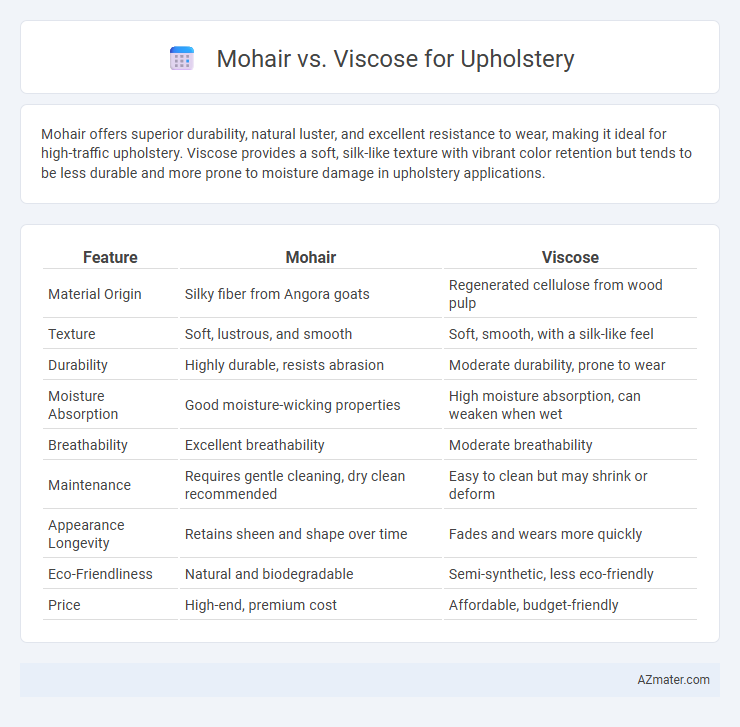Mohair offers superior durability, natural luster, and excellent resistance to wear, making it ideal for high-traffic upholstery. Viscose provides a soft, silk-like texture with vibrant color retention but tends to be less durable and more prone to moisture damage in upholstery applications.
Table of Comparison
| Feature | Mohair | Viscose |
|---|---|---|
| Material Origin | Silky fiber from Angora goats | Regenerated cellulose from wood pulp |
| Texture | Soft, lustrous, and smooth | Soft, smooth, with a silk-like feel |
| Durability | Highly durable, resists abrasion | Moderate durability, prone to wear |
| Moisture Absorption | Good moisture-wicking properties | High moisture absorption, can weaken when wet |
| Breathability | Excellent breathability | Moderate breathability |
| Maintenance | Requires gentle cleaning, dry clean recommended | Easy to clean but may shrink or deform |
| Appearance Longevity | Retains sheen and shape over time | Fades and wears more quickly |
| Eco-Friendliness | Natural and biodegradable | Semi-synthetic, less eco-friendly |
| Price | High-end, premium cost | Affordable, budget-friendly |
Introduction to Mohair and Viscose Upholstery
Mohair upholstery is prized for its durability, natural luster, and superior resistance to pilling, sourced from the Angora goat's silky fibers that provide a luxurious texture and excellent breathability. Viscose upholstery, a semi-synthetic fiber derived from cellulose, offers a soft, smooth feel with vibrant color retention and affordability, though it is less durable and more prone to moisture damage compared to natural fibers like mohair. Choosing between mohair and viscose depends on priorities such as longevity, ease of maintenance, and aesthetic preferences in upholstery applications.
What Is Mohair? Key Features and Benefits
Mohair is a luxurious natural fiber obtained from the Angora goat, renowned for its exceptional durability, sheen, and softness, making it ideal for upholstery. Key features of mohair include high tensile strength, resistance to staining and pilling, and excellent insulating properties that regulate temperature. These benefits result in upholstery fabric that is not only elegant and comfortable but also long-lasting and easy to maintain.
What Is Viscose? Key Features and Properties
Viscose is a semi-synthetic fiber made from regenerated cellulose, commonly derived from wood pulp, known for its soft texture and high versatility in upholstery applications. Key features of viscose include excellent drape, breathability, and a silk-like sheen that enhances the visual appeal of furniture fabrics. Its properties such as moisture absorption, color retention, and affordability make viscose a popular choice for upholstery compared to natural fibers like mohair, though it may require careful maintenance to prevent wear and tear.
Durability Comparison: Mohair vs Viscose
Mohair upholstery offers exceptional durability with resistance to wear and tear, maintaining its appearance despite frequent use, while viscose tends to be less durable and more prone to stretching and abrasion over time. Mohair fibers are naturally strong and resilient, making them ideal for high-traffic furniture, whereas viscose, derived from cellulose, may degrade faster under constant friction and exposure to sunlight. Choosing mohair over viscose for upholstery ensures a longer-lasting fabric performance and sustained aesthetic appeal in demanding environments.
Stain Resistance and Cleaning Ease
Mohair upholstery offers superior stain resistance due to its natural lanolin content, which repels liquids and prevents dirt absorption, making it easier to clean with gentle brushing or spot cleaning. Viscose, derived from cellulose fibers, tends to absorb stains quickly and requires professional cleaning to avoid fabric damage, limiting its practicality for high-traffic areas. Choosing mohair ensures enhanced durability and low-maintenance care, ideal for upholstery exposed to frequent use and spills.
Texture and Visual Appeal Differences
Mohair upholstery fabric boasts a luxurious texture characterized by a smooth, silky feel and a natural sheen that enhances light reflection, making furniture appear more vibrant and elegant. Viscose upholstery offers a softer, plush texture with a matte finish, providing a cozy and inviting look but less lustrous compared to mohair. The visual appeal of mohair is marked by its subtle iridescence and durability, while viscose contributes warmth and softness, often resembling natural fibers like cotton or silk.
Comfort Factors: Feel and Breathability
Mohair upholstery offers a luxurious, soft texture with excellent durability and natural moisture-wicking properties, enhancing comfort by maintaining a cool, breathable surface. Viscose provides a smooth, silky feel but tends to retain heat and moisture, potentially reducing breathability compared to natural fibers like mohair. Choosing mohair maximizes airflow and temperature regulation, making it ideal for comfortable, long-term upholstery use.
Cost Analysis: Mohair vs Viscose Pricing
Mohair upholstery commands a higher price due to its natural origin, durability, and luxurious texture, often costing between $50 to $150 per yard, making it a premium choice for high-end furniture. In contrast, viscose offers a more budget-friendly alternative, with prices ranging from $10 to $30 per yard, appealing to cost-conscious consumers seeking the look of silk or wool without the expense. Evaluating cost-efficiency involves balancing mohair's long-lasting strength and resistance to wear against viscose's affordability but lower durability in upholstery applications.
Sustainability and Environmental Impact
Mohair, a natural fiber derived from Angora goats, offers superior sustainability due to its biodegradability and renewable sourcing, though its environmental impact hinges on responsible farming practices to minimize land degradation and water use. Viscose, a semi-synthetic fiber made from cellulose, often involves resource-intensive chemical processing and deforestation risks but can be more sustainable when produced through closed-loop manufacturing with eco-friendly certifications. Choosing mohair supports biodiversity and renewable agriculture, while sustainable viscose production contributes to reduced chemical pollution and forest conservation.
Which Is Best for Upholstery? Final Recommendations
Mohair offers exceptional durability, natural sheen, and excellent resistance to wear, making it a premium choice for upholstery in high-traffic areas. Viscose, while softer and more affordable, tends to be less durable and more prone to moisture damage and fading over time. For long-lasting, elegant upholstery with superior resilience, mohair is the best option, whereas viscose suits decorative or low-traffic furniture where budget is a key consideration.

Infographic: Mohair vs Viscose for Upholstery
 azmater.com
azmater.com